I've been working on a VHDL project for a few weeks, and functionnality-wise everything's going very smoothly. I can simulate and program my DE0-nano FPGA devellopement board to check if what I'm doing is working, and it is. However, I'm starting to worry about the readability of the source code as the project is rapidly expanding.
As far as my experience is concerned, I'm a university student in electronical engineering and have followed many courses on electronics, but I'm a complete noob concerning VHDL. (Although I could say my knowledge of VHDL has grown immensely during these past few weeks)
THE QUESTION :
My problem is that I have several components whose ports I'd like to map individually into DIFFERENT high-level entities. Say you've got an adder.vhd, well I'd like to provide operand A from operandA.vhd and operand B from operandB.vhd, meaning that I'd like to map port A of adder.vhd into operandA.vhd, and port B of adder.vhd into operandB.vhd.
The solution I'm currently using is that I map my signals following the hierarchical order of my entities, and if operandB.vhd is buried at another level entirely than operandA.vhd, I map the signals all the way through to the highest level entity that is required, then back down into the adder.vhd, in a single port map specifying ports A and B at the same time as I believe is required.
However, I find this solution very messy as it accumulates signals in my high-level entities that are only there for routing purposes. What's more, to continue on the adder.vhd analogy, I'd like several entities to provide operandsA or B (at different times, I'm not going to drive different values on the same input ports) so applying the current solution means I'll have numerous near-duplicate assignements too.
Is there another solution ? I couldn't find any documentation on this, and I fear this is a hard constraint of the language, but I may not know quack as I'm just starting VHDL.
This may also be a design error on my side, as I'm more accustomed to actual electronic design than VHDL circuit description. Connecting a component's ports to a bunch of other different components is very natural, but may not be how VHDL works.
EXPLICATIVE BLOCK DIAGRAMS :
What I'm currently doing : https://i.stack.imgur.com/CJVjg.gif

What I want to do : https://i.stack.imgur.com/hrNwF.gif

EXAMPLE CODE :
-- ********************************************
--
-- TOP-LEVEL ENTITY, in a file topLevel.vhd
entity topLevel is
port
(
-- Any ports, not useful for the problem at hand
);
end entity topLevel ;
architecture topLevel_Architecture of topLevel is
-- HERE : I have to accumulate signals just to get my data from the two subEntityA & B to computeFromAB.
--
-- I can't just map subEntityA and subEntityB as low-level entites into computeFromAB, as they provide data
-- that I need elsewhere in the circuit. Well, I could do that but then I'd still have to get the "otherSignalFromX"
-- through the same method.
--
-- I'd rather directly map SEPARATELY (if that's possible)
-- - operandA & operandB into computeFromAB
-- - otherSignalFromA & otherSignalFromB into topLevel
-- The signals I use to get my data from subEntityA and subEntityB to computeFromAB
SIGNAL operandA : std_logic_vector(7 downto 0) := ( others => '0' ) ;
SIGNAL operandB : std_logic_vector(7 downto 0) := ( others => '0' ) ;
-- Other signals that I do not need to get to computeFromAB
SIGNAL otherSignalFromA : std_logic ;
SIGNAL otherSignalFromB : std_logic ;
begin
-- PORT MAP : subEntityA.vhd
subEntityA : entity work.subEntityA
PORT MAP(
-- The first signal I'd like to get through to computeFromAB
operandA => operandA,
-- Other signals
otherSignalFromA => otherSignalFromA
);
-- PORT MAP : subEntityB.vhd
subEntityB : entity work.subEntityB
PORT MAP(
-- The second signal I'd like to get through to computeFromAB
operandB => operandB,
-- Other signals
otherSignalFromB => otherSignalFromB
);
-- PORT MAP : computeFromAB.vhd
computeFromAB : entity work.computeFromAB
PORT MAP(
-- The "useful" signals
operandA => operandA,
operandB => operandB
);
-- PROCESSES, ETC, OF TOPLEVEL ENTITY
end topLevel_Architecture ;
-- ********************************************
--
-- OPERAND A ENTITY, in a file subEntityA.vhd
entity subEntityA is
port
(
-- The first signal I'd like to get through to computeFromAB
operandA : OUT std_logic_vector(7 downto 0)
-- Other signals
otherSignalFromA : OUT std_logic ;
);
end entity subEntityA ;
-- ARCHITECTURE, PROCESSES OF subEntityA
-- ********************************************
--
-- OPERAND B ENTITY, in a file subEntityB.vhd
entity subEntityB is
port
(
-- The second signal I'd like to get through to computeFromAB
operandB : OUT std_logic_vector(7 downto 0)
-- Other signals
otherSignalFromB : OUT std_logic ;
);
end entity subEntityB ;
-- ARCHITECTURE, PROCESSES OF subEntityB
-- ********************************************
--
-- COMPUTATION FROM OPERANDS A & B ENTITY, in a file computationFromAB.vhd
entity computeFromAB is
port
(
operandA : IN std_logic_vector(7 downto 0) ;
operandB : IN std_logic_vector(7 downto 0)
);
-- ARCHITECTURE, PROCESSES OF computeFromAB
Thanks for reading, and thanks for any input you may provide.
EDIT 1 : Thanks for removing the "dictionary" tag, no idea why it was there.
EDIT 2 : added some example code, though I'm not sure if it's any help
EDIT 3 : added illustrative block diagrams